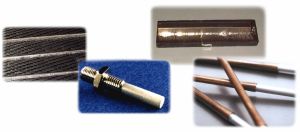S-Bond material joining applications enable engineers to use multiple materials, such as materials and ceramics, in a variety of applications. However, just because aluminum and steel can be joined, as one example, does not mean that the joining process cannot introduce deformations or other issues.
Thermal Expansion Concerns in Bonding
When soldering two different types of metal together, both surfaces have to be heated in  order for the solder to bond to both components. Materials expand as they heat, and different metals do so at a different rate. This can create problems as the joining site cools back down.
order for the solder to bond to both components. Materials expand as they heat, and different metals do so at a different rate. This can create problems as the joining site cools back down.
Two examples of materials that react easily to heat are aluminum and magnesium, which can expand at twice the rate of carbon steel and iron. If an aluminum sheet is soldered to a sheet of carbon steel, during the cool-down period the combined piece will warp with a slight curve. With more brittle components such as those made with ceramics, the combined part can shatter based on expansion during bonding and later cooling.
Solutions for Dissimilar Coefficients of Thermal Expansion
The simplest way to deal with thermal expansion concerns is to match materials that react similarly to heat, so that the expansion and contraction rates are about the same. However, S-Bond Technologies also recommends creating a mosaic, where the bonding occurs over a smaller surface area by splitting up parts, or using multiple layers over a distance.
S-Bond can also be used, as it requires a lower temperature in order to create a bond, reducing the amount of expansion. That can be particularly important with many applications requiring the cost-effective and lightweight aluminum. The solder bonding can be used to join aluminum to steel, aluminum oxide or graphite. It also helps create better seals, and compared to glues or epoxies, can maintain conductivity which is crucial for many electronics products.
Compression, Tensile and Shear Strength of Dissimilar Bonded Materials
There are a number of stresses that can act on materials in various applications, but three important ones for bonding materials are compression and tensile, as well as torsional. Compression and tensile are inverses of each other, with a tensile stress trying to pull the pieces apart and compression stresses working to push the materials together. Shear stresses twist bonded materials around any axis.
Going back to the joining of an aluminum piece to a stainless steel piece, the differences in tensile strength are substantial: an aluminum alloy may be able to handle strains of roughly 30,000 pounds per square inch (psi) while cold-rolled stainless steel’s tensile strength is four times that.
In addition, the shear strength is usually much lower than tensile strength, which can be a significant limiting factor for applications using weaker and often lighter materials.
Solutions for Disparate Material Strengths
There are usually three options available for engineers whose applications currently call for materials with different strengths, like ceramics versus steel or aluminum versus titanium: limiting the expected forces on the end product to the level of the weakest component, substituting out that material, or re-designing so that a metal like aluminum will not be subjected to extreme stresses.
The first option may not be feasible for many industrial products that need to provide end users with significant lifetimes or need to be rugged and deal with a number of environmental factors. Substituting the material with one that has higher shear and tensile strength will usually provide the fewest issues but often at a higher cost.
Re-designing can result in different changes. Either the weakest material can be moved or bonded to another location if possible, leaving the pieces better able to deal with shear and tensile stresses to handle the brunt of an expected forces. It may also be possible to use some of the techniques listed above to limit thermal expansion concerns to also mitigate the issues regard stresses.
Get Help With Your Multi-Material Applications.
Employees at S-Bond have spent years developing processes that provide flexibility in joining various metals, ceramics and other components for industrial applications. Engineers and others who are looking to find the right joining procedure for their needs can click on the contact S-Bond for a consultation about bonding and other types of joining. For more immediate assistance, call S-Bond Technologies at 215-631-7114 today.
